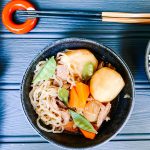
Niku Jaga
Niku Jaga is a warm, comforting Japanese meat stew made from potatoes, sliced beef, (although pork is often used in Eastern Japan) shirataki noodles, carrots, onion and a delectable sweetened stock made from dashi, soy, cooking sake and mirin
Ingredients
For the stock and seasoning:
- ½ cup/120ml soy sauce
- ½ cup/120ml mirin
- ¼ cup/60ml cooking sake
- 2 tablespoons caster or granulated sugar
- 2 pouches of dashi powder
- 1 litre water
For the stew:
- 2 large onions, peeled (roughly 300g in total)
- 2 tablespoons vegetable oil
- 2 medium sized peeled carrots (roughly 150g total peeled weight)
- 4 medium peeled potatoes (roughly 300g total peeled weight)
- 500g beef – chuck or rump
- 200g shirataki noodles
- a few snow peas/mange tout for decoration
Instructions
-
Collect together your equipment (see Recipe Notes below) and ingredients.
-
Beef - Top tip: it is much easier to slice beef thinly if you put it in the freezer for half an hour before you slice it. This is the first thing I do before making a Niku Jaga.
-
Make the seasoning: simply add the soy sauce, cooking sake and mirin to the sugar and stir to mix. The sugar will dissolve as you prepare the rest of the stew.
-
Dashi stock: stir the dashi powder into the water and stir well to mix. I use the two attached pouches per 1 litre of water.
-
Prepare all the stew ingredients:
Potatoes - cut the peeled potatoes into quarters and smooth the edges of the potatoes by trimming the sharp edges. This Japanese cutting technique is called mentori. Soak the potatoes in water to remove starch.
Onions - cut each peeled onion half and then each half into 6 wedges.
Carrots - cut the peeled carrots in half lengthwise and chop into rolling wedges.
Snow peas/green beans - cook in boiling water for 10 seconds and take them out.
Shirataki noodles - drain and rinse the shirataki noodles. Add the shirataki noodles to the boiling water you cooked the snow peas in and cook for 1 minute. Drain well and cut in half.
Beef – thinly slice the beef.
-
Cook the Niku Jaga:
Using a large pot, heat the oil on medium and sauté the onion for 5 minutes until lightly caramelised.
-
Add the beef and cook until no longer pink; just a couple of minutes.
-
Rinse the potatoes and add to the onions and beef along with the carrots and shirataki noodles – do not mix the ingredients
-
Pour in the seasonings and the dashi stock. Bring gently to the boil.
-
Simmering gently, skim the scum from the surface and discard.
-
Meanwhile using the lid of your pot as a size guide, make an ‘otoshibuta’ (drop lid) out of aluminium foil. (See pictures above.)
-
When the stock is as clear as you can make it, make sure as many ingredients as possible are submerged. Cover with the ‘otoshibuta’ and a lid
-
Cook for 15-20 minutes or until all the vegetables are cooked through. Turn off the heat and let it stand for 30 minutes before serving so the ingredients can further absorb the flavours.
NB - I cook mine for 20 minutes because we like the potatoes very soft – cooking for 15 minutes is perhaps slightly more traditional. However cooking time will also depend on the size and type of your potatoes.
-
When you heat it up again prior to serving, pour the soup on top of the ingredients with a spoon a couple of times. When it’s almost ready, toss in the snow peas to warm them through. Make sure all the ingredients are piping hot before you serve.
-
I like to serve my Niku Jaga either on or with rice on the side to absorb all the delicious stock. Although my photographs show chopsticks, I also use a spoon to catch all the wonderful flavours!
Recipe Notes
Equipment:
- kitchen scales and measuring spoons and 2 x measuring jugs
- chopping board and knife
- bowl to soak the peeled potatoes in
- cast iron casserole dish - I use a 26inch/66cm cast iron casserole dish.
- ‘otoshibuta'/drop lid
Otoshibuta/Drop lid
Use the lid of your pot as a size guide, to make an ‘otoshibuta’ (drop lid) out of aluminium foil. Thus helps the heat to distribute evenly. It helps prevent the food from moving and ensures the different ingredients stay submerged in the stock. It also reduces the chance of large bubbles forming which can put stress on the food. As such, it will help to ensure that fragile ingredients, in this case the potatoes, keep their shape.
I confess I don't always do this, but it is the proper way. I do however make sure that the stew is bubbling only very gently and I ensure the ingredients fit snugly in my pot to prevent too much movement. I use a 26inch/66cm cast iron casserole dish.
Additional Ingredients:
Although not traditional, you could try adding the following to the stock:
- 10g minced garlic
- 10g minced ginger
- 2 teaspoons sesame oil
- ¼ teaspoon ground black pepper